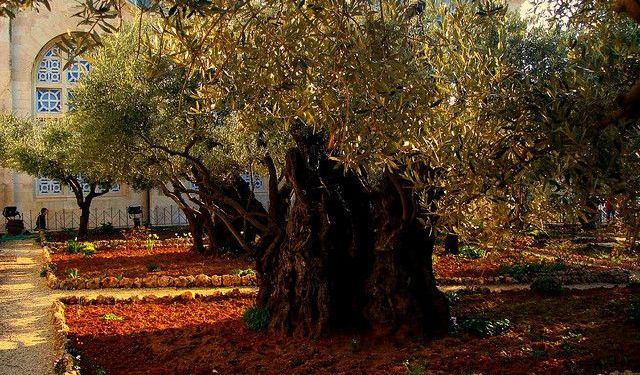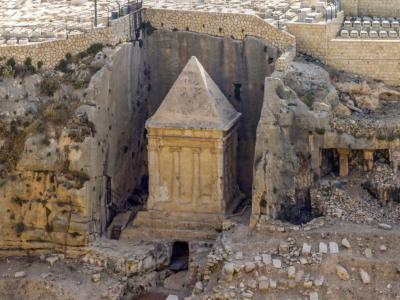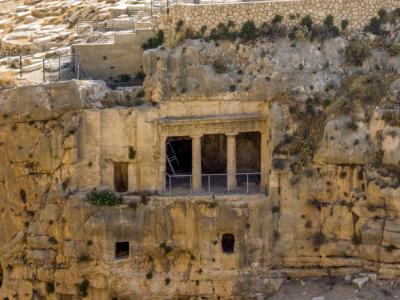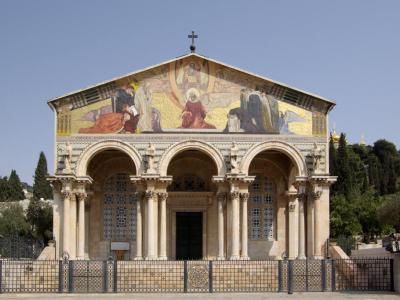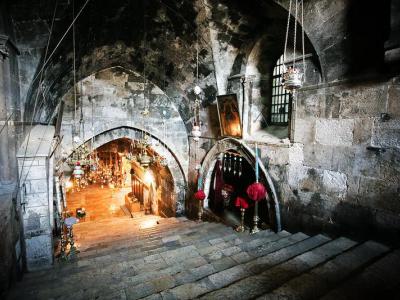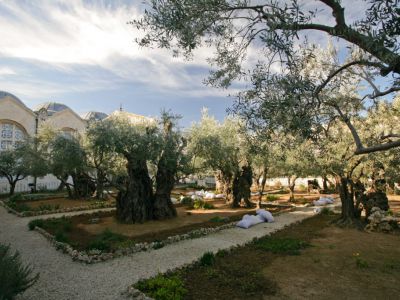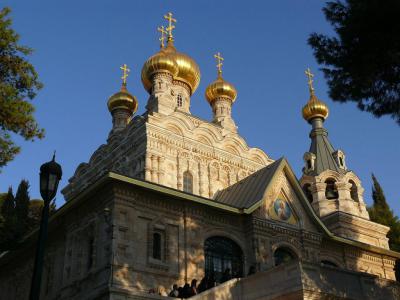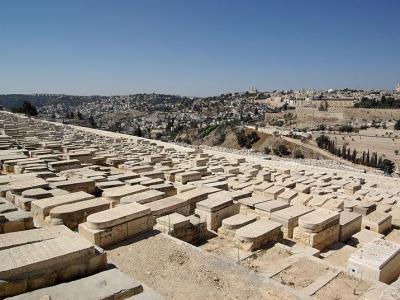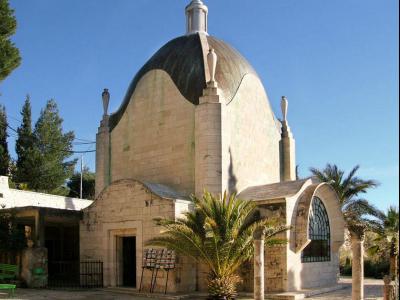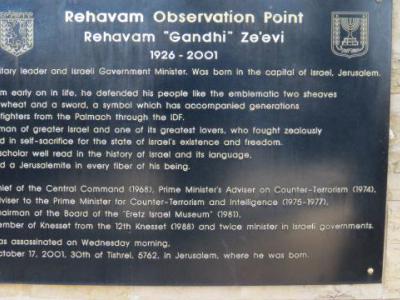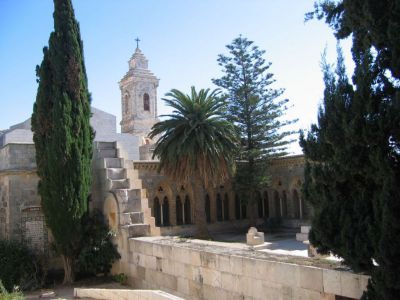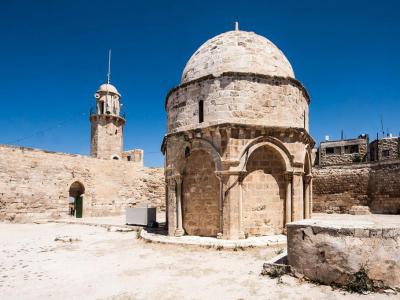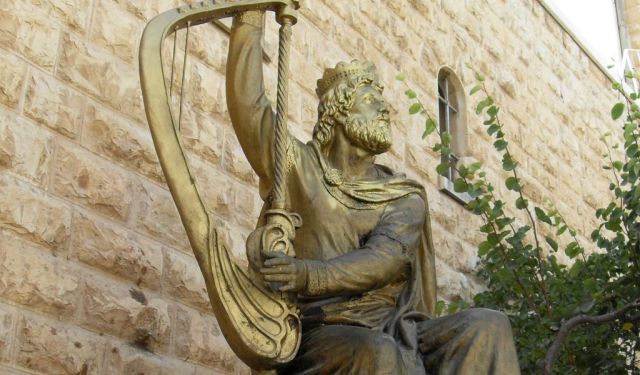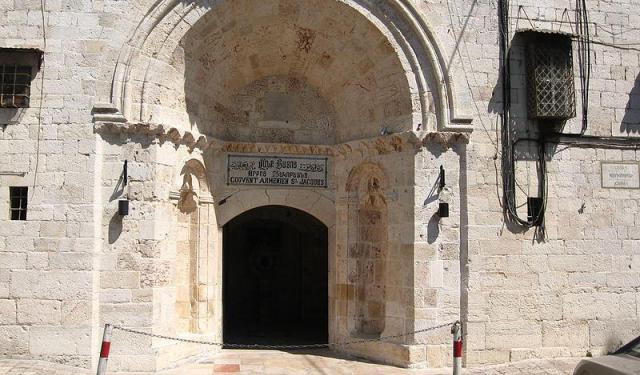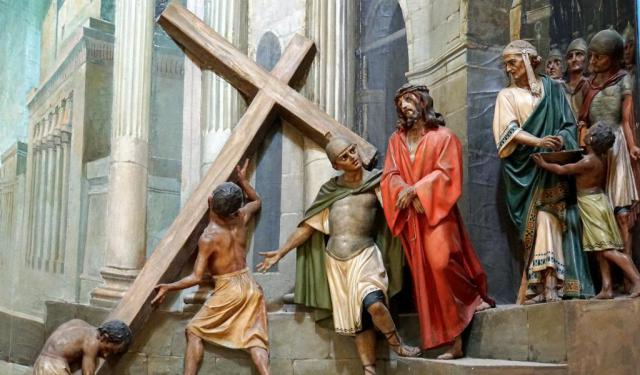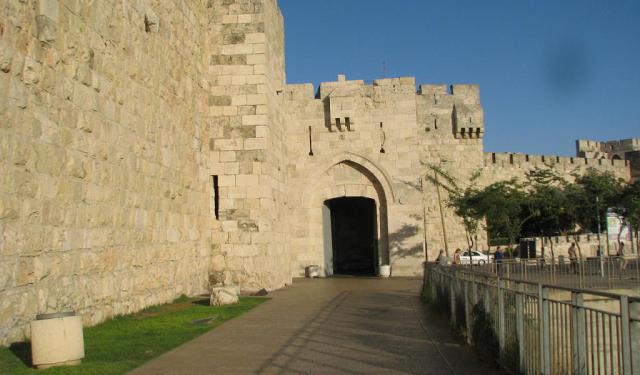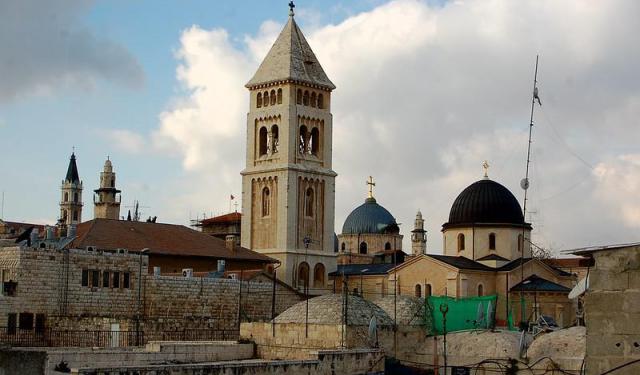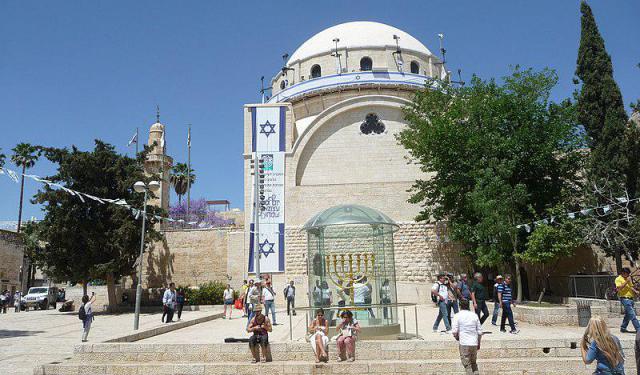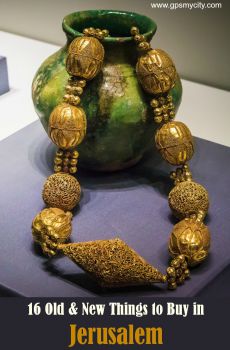Mount of Olives Walking Tour (Self Guided), Jerusalem
Aside from affording great views over the Old City, the Mount of Olives is home to half a dozen major sites of the Christian faith along with the oldest Jewish burial ground in the world. Considered a holy spot by many, it is associated with numerous events in Jesus’ life including ascending to Heaven and teaching his disciples the Lord’s Prayer.
The following self-guided walking tour will lead you through the Mount of Olives’ most prominent landmarks, starting with the Kidron Valley where the tombs of Zechariah and Benei Hezir can be found, both carved out of solid rock and set amid the expansive Jewish cemetery, believed by many locals to be the future sight of the Resurrection.
From the base of the mountain, you will go toward the Church of All Nations (1924) whose row of pillars and magnificent mosaic on the front directly face the road. Completed with donations from a dozen different countries, the impressive church features massive frescoes painted on vaulted walls as well as a large rock believed to be the place where Jesus prayed the night of his betrayal and arrest. Just north is the supposed resting place of the Virgin Mary with a very moving underground altar, while the Garden of Gethsemane, where Jesus is said to have been betrayed by Judas, is accessible from a nearby alley.
Farther up the hill, adjacent to the Old Jewish Cemetery, the Franciscan Dominus Flevit Church (1954), with its tear-shaped dome, stands on a site considered holy as far back as the Bronze Age; the Church of the Pater Noster is famed for its 140 inscriptions of the Lord’s Prayer in different languages; and, finally, the Chapel of the Ascension marks the spot where Jesus is said to have risen to heaven 40 days after his resurrection.
Clearly a highly special site in Jerusalem you cannot miss – so follow our self-guided walking tour to best explore its many different facets without need of a guide.
The following self-guided walking tour will lead you through the Mount of Olives’ most prominent landmarks, starting with the Kidron Valley where the tombs of Zechariah and Benei Hezir can be found, both carved out of solid rock and set amid the expansive Jewish cemetery, believed by many locals to be the future sight of the Resurrection.
From the base of the mountain, you will go toward the Church of All Nations (1924) whose row of pillars and magnificent mosaic on the front directly face the road. Completed with donations from a dozen different countries, the impressive church features massive frescoes painted on vaulted walls as well as a large rock believed to be the place where Jesus prayed the night of his betrayal and arrest. Just north is the supposed resting place of the Virgin Mary with a very moving underground altar, while the Garden of Gethsemane, where Jesus is said to have been betrayed by Judas, is accessible from a nearby alley.
Farther up the hill, adjacent to the Old Jewish Cemetery, the Franciscan Dominus Flevit Church (1954), with its tear-shaped dome, stands on a site considered holy as far back as the Bronze Age; the Church of the Pater Noster is famed for its 140 inscriptions of the Lord’s Prayer in different languages; and, finally, the Chapel of the Ascension marks the spot where Jesus is said to have risen to heaven 40 days after his resurrection.
Clearly a highly special site in Jerusalem you cannot miss – so follow our self-guided walking tour to best explore its many different facets without need of a guide.
How it works: Download the app "GPSmyCity: Walks in 1K+ Cities" from Apple App Store or Google Play Store to your mobile phone or tablet. The app turns your mobile device into a personal tour guide and its built-in GPS navigation functions guide you from one tour stop to next. The app works offline, so no data plan is needed when traveling abroad.
Mount of Olives Walking Tour Map
Guide Name: Mount of Olives Walking Tour
Guide Location: Israel » Jerusalem (See other walking tours in Jerusalem)
Guide Type: Self-guided Walking Tour (Sightseeing)
# of Attractions: 11
Tour Duration: 1 Hour(s)
Travel Distance: 1.7 Km or 1.1 Miles
Author: vickyc
Sight(s) Featured in This Guide:
Guide Location: Israel » Jerusalem (See other walking tours in Jerusalem)
Guide Type: Self-guided Walking Tour (Sightseeing)
# of Attractions: 11
Tour Duration: 1 Hour(s)
Travel Distance: 1.7 Km or 1.1 Miles
Author: vickyc
Sight(s) Featured in This Guide:
- Tomb of Zechariah
- Tomb of Benei Hezir
- Church of All Nations
- Tomb of the Virgin Mary
- Garden of Gethsemane
- Church of St. Mary Magdalene
- Old Jewish Cemetery
- Dominus Flevit Church
- Rehavam Observation Point
- Church of the Pater Noster
- Chapel of the Ascension
1) Tomb of Zechariah
Adjacent to the Tomb of Benei Hezir and just a few meters from the Tomb of Absalom, this imposing monument in the Kidron Valley was erected in memory of Zechariah, a minor prophet mentioned in the Old Testament who, according to the Book of Chronicles, was stoned:
"Then the Spirit of God came upon Zechariah, son of Jehoiada the priest, who stood up before the people and said to them, “This is what God says: ‘Why do you transgress the commandments of the LORD so that you cannot prosper? Because you have forsaken the LORD, He has forsaken you.’ ” But they conspired against Zechariah, and by order of the king, they stoned him in the courtyard of the house of the LORD. Thus King Joash failed to remember the kindness that Zechariah’s father Jehoiada had extended to him. Instead, Joash killed Jehoiada’s son. As he lay dying, Zechariah said, “May the LORD see this and call you to account.”"
Carved entirely from solid rock (a remarkable feat indeed!), the monolith stands out for its pyramid-shaped upper portion; however, its overall style, which includes Hellenistic details like Ionic columns, closely resembles that of the Tomb of Benei Hezir, leading scholars to believe that they are near-contemporary with one another. Funerary experts have dated the tomb to the 1st century CE. Impressively large, it is stands amidst the world's oldest and largest Jewish cemetery and can be ascended for panoramic views of the valley.
"Then the Spirit of God came upon Zechariah, son of Jehoiada the priest, who stood up before the people and said to them, “This is what God says: ‘Why do you transgress the commandments of the LORD so that you cannot prosper? Because you have forsaken the LORD, He has forsaken you.’ ” But they conspired against Zechariah, and by order of the king, they stoned him in the courtyard of the house of the LORD. Thus King Joash failed to remember the kindness that Zechariah’s father Jehoiada had extended to him. Instead, Joash killed Jehoiada’s son. As he lay dying, Zechariah said, “May the LORD see this and call you to account.”"
Carved entirely from solid rock (a remarkable feat indeed!), the monolith stands out for its pyramid-shaped upper portion; however, its overall style, which includes Hellenistic details like Ionic columns, closely resembles that of the Tomb of Benei Hezir, leading scholars to believe that they are near-contemporary with one another. Funerary experts have dated the tomb to the 1st century CE. Impressively large, it is stands amidst the world's oldest and largest Jewish cemetery and can be ascended for panoramic views of the valley.
2) Tomb of Benei Hezir
Dating back to the time of the Second Temple (2nd century BCE), this is the oldest of four monumental rock-cut tombs that stand in the Kidron Valley, bearing witness to the Hellenistic period and the era of the Hasmonean monarchy in Jewish history. Carved into the cliff, the tomb resembles a burial cave and exhibits architectural elements influenced by ancient Greece (two pillars with Doric capitals) and Nabataean culture (popular among some Judaean families for its decorative motifs), but notably lacks any Egyptian influences.
The tomb's Hebrew inscription identifies it as the burial site of a priestly family known as Benei Hezir. In the Hebrew Bible, there are two mentions of men named Hezir: one was the founder of the 17th priestly division, while the other was among the leaders who sealed the covenant with Nehemiah. Whether there is any connection between the family interred here and the biblical Hezirs remains unknown.
Tip:
You can approach the tomb complex on foot, or watch it from the roadside just outside the Old City. Walk along Maale Ha-Shalom on the valley side of the road until you are directly above the tomb. There you'll find a viewpoint equipped with a layout map and an audio device providing insightful commentary on the monuments below.
The tomb's Hebrew inscription identifies it as the burial site of a priestly family known as Benei Hezir. In the Hebrew Bible, there are two mentions of men named Hezir: one was the founder of the 17th priestly division, while the other was among the leaders who sealed the covenant with Nehemiah. Whether there is any connection between the family interred here and the biblical Hezirs remains unknown.
Tip:
You can approach the tomb complex on foot, or watch it from the roadside just outside the Old City. Walk along Maale Ha-Shalom on the valley side of the road until you are directly above the tomb. There you'll find a viewpoint equipped with a layout map and an audio device providing insightful commentary on the monuments below.
3) Church of All Nations (must see)
The Church of All Nations, also known as the Basilica of the Agony, holds a significant place in Christian tradition, believed to mark the site where Jesus prayed before his arrest in the Garden of Gethsemane. The original 4th-century church at this site was devastated by an earthquake in 747. Subsequently, the Crusaders erected a new structure, strategically aligned to encompass three rocky outcrops, symbolizing Christ's three prayers during that fateful night. Consecrated in 1170, it gradually fell into disrepair after 1345.
In the early 20th century, excavations led to the church's modern iteration, designed by Antonio Barluzzi and completed in 1924 through contributions from 12 nations, hence its name and the 12 golden cupola ceilings bearing national coats of arms. At the heart of the nave lies the Byzantine-era rock, encircled by a wrought-iron crown of thorns. The apse mosaic vividly portrays Christ's Agony, while adjacent scenes depict his arrest and Judas's betrayal. Traces of the Byzantine church's layout are etched in black marble on the floor, with remnants of its mosaic pavement still visible.
Outside, the striking gilded mosaic adorning the pediment also portrays the Agony, while an open-air altar nestled within the gardens serves as a place of worship for various Christian denominations, including Roman Catholic, Eastern Orthodox, Armenian Apostolic, Protestant, Lutheran, Evangelical, Anglican, and other culturally distinct branches of Christianity.
In the early 20th century, excavations led to the church's modern iteration, designed by Antonio Barluzzi and completed in 1924 through contributions from 12 nations, hence its name and the 12 golden cupola ceilings bearing national coats of arms. At the heart of the nave lies the Byzantine-era rock, encircled by a wrought-iron crown of thorns. The apse mosaic vividly portrays Christ's Agony, while adjacent scenes depict his arrest and Judas's betrayal. Traces of the Byzantine church's layout are etched in black marble on the floor, with remnants of its mosaic pavement still visible.
Outside, the striking gilded mosaic adorning the pediment also portrays the Agony, while an open-air altar nestled within the gardens serves as a place of worship for various Christian denominations, including Roman Catholic, Eastern Orthodox, Armenian Apostolic, Protestant, Lutheran, Evangelical, Anglican, and other culturally distinct branches of Christianity.
4) Tomb of the Virgin Mary
Tucked away in the Valley of Jehoshaphat, just beyond the City Walls and alongside Gethsemane, lies a sanctuary steeped in mystique: the underground chamber believed to be the resting place of the Virgin Mary. What sets this site apart is its unique entrance – a descent down nearly 50 Crusader-built steps, a symbolic journey into the depths of faith.
The unassuming facade belies the rich history within, marked by the grand staircase erected by the Crusaders and the side tombs halfway down, purportedly reserved for royal burials during the 12th century. Among these, the tomb on the right, descending, holds special reverence as the resting place of Saints Anne and Joachim, parents of Mary.
The roots of this sanctum trace back to the 1st century AD, with the current cruciform crypt, predominantly hewn from solid rock, reflecting Byzantine craftsmanship. Within its eastern branch, adorned with icons and embellishments, stands the Tomb of Mary, a focal point of veneration for Armenian, Greek, Coptic, and Syrian Christians alike. Interestingly, Muslims also hold this site sacred, as legend has it that Muhammad witnessed a divine light emanating from the tomb of his "sister Mary" during his Night Journey to Jerusalem. Outside, adjacent to the facade, lies the Cave of Gethsemane, also known as the Cave of the Betrayal, where tradition places Judas's infamous act.
The unassuming facade belies the rich history within, marked by the grand staircase erected by the Crusaders and the side tombs halfway down, purportedly reserved for royal burials during the 12th century. Among these, the tomb on the right, descending, holds special reverence as the resting place of Saints Anne and Joachim, parents of Mary.
The roots of this sanctum trace back to the 1st century AD, with the current cruciform crypt, predominantly hewn from solid rock, reflecting Byzantine craftsmanship. Within its eastern branch, adorned with icons and embellishments, stands the Tomb of Mary, a focal point of veneration for Armenian, Greek, Coptic, and Syrian Christians alike. Interestingly, Muslims also hold this site sacred, as legend has it that Muhammad witnessed a divine light emanating from the tomb of his "sister Mary" during his Night Journey to Jerusalem. Outside, adjacent to the facade, lies the Cave of Gethsemane, also known as the Cave of the Betrayal, where tradition places Judas's infamous act.
5) Garden of Gethsemane (must see)
A place of great resonance in Christianity, this beautiful walled garden at the foot of the Mount of Olives, revered since the apostolic period, is the site where – according to the four Gospels of the New Testament – Jesus experienced the agonizing premonition of his passion and death, and where he was arrested the night before his crucifixion. The name "Gethsemane" is derived from Aramaic and means "oil press," likely indicating that the area was once used for pressing olive oil.
Beyond the religious significance, the garden is essentially an urban olive orchard, with eight distinctive ancient trees among others. Carbon dating estimates the eight trees to be over 900 years old (as such, amongst the oldest known to science), having descended from the same parent tree – possibly itself a descendant from the original trees of Christ's time. They still produce fruit but are fenced off so unless you gracefully tip the gatekeeper, you can't go walking among them.
Also be sure to visit the adjacent Church of All Nations on the grounds, also known as the Basilica of the Agony, which holds a section of bedrock believed to be where Jesus prayed before his arrest – but make very sure your knees, shoulders and upper arms are properly covered, preferably with clothing and not just a shawl, or you will be refused entry. Women should avoid wearing shorts of any length.
Beyond the religious significance, the garden is essentially an urban olive orchard, with eight distinctive ancient trees among others. Carbon dating estimates the eight trees to be over 900 years old (as such, amongst the oldest known to science), having descended from the same parent tree – possibly itself a descendant from the original trees of Christ's time. They still produce fruit but are fenced off so unless you gracefully tip the gatekeeper, you can't go walking among them.
Also be sure to visit the adjacent Church of All Nations on the grounds, also known as the Basilica of the Agony, which holds a section of bedrock believed to be where Jesus prayed before his arrest – but make very sure your knees, shoulders and upper arms are properly covered, preferably with clothing and not just a shawl, or you will be refused entry. Women should avoid wearing shorts of any length.
6) Church of St. Mary Magdalene
In the 1880s, Tsar Alexander III had this Russian Orthodox church raised in memory of his mother, Empress Maria Alexandrovna, who passed away when he was just a toddler. Set amid trees, its seven gilded onion domes, each topped with a tall golden cross, are among the most striking features of the skyline seen from the Old City. These and other architectural features are in 16th- to 17th-century Muscovite style, though the church is equally worth a visit for the delightful icons and murals inside, depicting the life of Mary Magdalene, the first recorded witness of Christ's resurrection.
Completely in harmony with the entourage, Saint Mary Magdalene's is a striking contrast to others in Jerusalem and is worth looking out for when scanning the Mount of Olives. To this day it is the final resting place for Grand Duchess Elizabeth Feodorovna of Russia who was martyred during the Bolshevik Revolution in 1917, alongside her fellow nun, Varvara Yakovleva. Also buried here is Princess Alice of Greece, Queen Elizabeth’s mother-in-law, who sheltered Jews during the Nazi occupation of Greece. A museum in the convent preserves a beautiful 5th-century mosaic dedicated to "Susannah mother of Artavan".
Completely in harmony with the entourage, Saint Mary Magdalene's is a striking contrast to others in Jerusalem and is worth looking out for when scanning the Mount of Olives. To this day it is the final resting place for Grand Duchess Elizabeth Feodorovna of Russia who was martyred during the Bolshevik Revolution in 1917, alongside her fellow nun, Varvara Yakovleva. Also buried here is Princess Alice of Greece, Queen Elizabeth’s mother-in-law, who sheltered Jews during the Nazi occupation of Greece. A museum in the convent preserves a beautiful 5th-century mosaic dedicated to "Susannah mother of Artavan".
7) Old Jewish Cemetery
A large cemetery occupies the western and southern slopes of the Mount of Olives – the oldest continually used Jewish cemetery in the world. Since ancient times, people of Jewish religion have desired to be buried in this very place in the Holy Land since, according to the Bible, it is precisely where the resurrection of the dead will begin when the Messiah returns to Earth. Many characters from the past, some of whom are also mentioned in psalms and verses of ancient sacred texts, rest here.
Among the oldest tombs, at the foot of the Mount in the Kidron Valley, are those of Absalom, the son of David, and Zechariah, the priest of the First Temple, while other tombs have inscriptions bearing the name of families that lived 2,000 years ago. Burials have occurred continuously throughout history, with only a brief interruption during the period between the Arab-Israeli War and the Six-Day War (1948-1967). In Jewish tradition, visitors to the cemetery often place stones on the cenotaphs or gravestones instead of using flowers, as stones are symbolic of permanence and continuity. This gesture serves as a way to show that the deceased are not forgotten.
From the summit of the Mount of Olives, one can enjoy the most evocative panorama of the Holy City, with prominent landmarks such as the Dome of the Rock visible in the distance – an absolute must for first-timers to Jerusalem!
Among the oldest tombs, at the foot of the Mount in the Kidron Valley, are those of Absalom, the son of David, and Zechariah, the priest of the First Temple, while other tombs have inscriptions bearing the name of families that lived 2,000 years ago. Burials have occurred continuously throughout history, with only a brief interruption during the period between the Arab-Israeli War and the Six-Day War (1948-1967). In Jewish tradition, visitors to the cemetery often place stones on the cenotaphs or gravestones instead of using flowers, as stones are symbolic of permanence and continuity. This gesture serves as a way to show that the deceased are not forgotten.
From the summit of the Mount of Olives, one can enjoy the most evocative panorama of the Holy City, with prominent landmarks such as the Dome of the Rock visible in the distance – an absolute must for first-timers to Jerusalem!
8) Dominus Flevit Church
Its name meaning "The Lord Wept", this Franciscan chapel on the western slope of the Mount of Olives recalls the incident described in the Gospels where Jesus, while riding toward Jerusalem on the first Palm Sunday, had his "great lament" for the future fate of the Jewish people and of the Second Temple. Designed by Italian architect Antonio Barluzzi to stylize the shape of a teardrop, it was built in the 1950s on the ruins of a 7th-century chapel, with part of the original apse preserved.
The views over the Dome of the Rock and the Old City from both the altar window and the serene gardens are justly famous and enough to justify a visit. Rich in symbolism, both physically and spiritually, Dominus Flevit also has a collection of carved stone ossuaries (100 BC to 300 AD) one can observe just after entering its gates and, more importantly perhaps, a fine early Christian mosaic from a 5th-century monastery, preserved in situ outdoors, to the side of the church door.
The views over the Dome of the Rock and the Old City from both the altar window and the serene gardens are justly famous and enough to justify a visit. Rich in symbolism, both physically and spiritually, Dominus Flevit also has a collection of carved stone ossuaries (100 BC to 300 AD) one can observe just after entering its gates and, more importantly perhaps, a fine early Christian mosaic from a 5th-century monastery, preserved in situ outdoors, to the side of the church door.
9) Rehavam Observation Point
Named after Rehavam Ze'evi, an Israeli general and politician, this observation point offers visitors an unparalleled view of Jerusalem's beauty and history. Day or night, the sights are spectacular, providing a window into the diverse cultures, religions, and historical layers that define Jerusalem. Tourists and locals alike frequent this promenade, drawn to its ambiance, ideal for introspection and appreciation.
The iconic domes and towers of the Old City dominate the view, providing a quintessential, picture-perfect panorama. The majestic gold Dome of the Rock and the neighboring black-domed al-Aqsa Mosque prominently feature in the skyline. Behind them, the gray dome of the Holy Sepulchre and the white dome of the Hurva Synagogue in the Jewish Quarter add to the tapestry of faiths and nations that have left their mark on Jerusalem. Further to the left, the cone-roofed Dormition Abbey and its adjacent clock tower grace Mount Zion.
Below the observation point lies the expansive Jewish cemetery, reputedly the world's oldest continuously used burial ground. For over two millennia, Jews have been laid to rest here, awaiting the Messiah's arrival and the promised resurrection. The raised structures marking the graves serve as tomb markers rather than crypts, with burial taking place underground.
The iconic domes and towers of the Old City dominate the view, providing a quintessential, picture-perfect panorama. The majestic gold Dome of the Rock and the neighboring black-domed al-Aqsa Mosque prominently feature in the skyline. Behind them, the gray dome of the Holy Sepulchre and the white dome of the Hurva Synagogue in the Jewish Quarter add to the tapestry of faiths and nations that have left their mark on Jerusalem. Further to the left, the cone-roofed Dormition Abbey and its adjacent clock tower grace Mount Zion.
Below the observation point lies the expansive Jewish cemetery, reputedly the world's oldest continuously used burial ground. For over two millennia, Jews have been laid to rest here, awaiting the Messiah's arrival and the promised resurrection. The raised structures marking the graves serve as tomb markers rather than crypts, with burial taking place underground.
10) Church of the Pater Noster
Past a grove of ancient olive trees, this church, set within an enclosed garden, was built over the grotto (cave) where Jesus is believed to have preached about the ultimate conflict of good and evil leading to the end of the world. The Crusaders, believing it to also be the place where Jesus taught his disciples the Lord's Prayer, gave the church its present name – "Pater Noster", Latin for "Our Father".
The original Eleona Basilica ("Basilica of Olives"), commissioned by Emperor Constantine in AD 326, with supervision by his mother, Saint Helena, was destroyed by the Persians 300 years later. While its ruins have been partly restored and are of interest to visitors, the current building dates back to the late 19th century when it was overseen by contemplative Carmelite nuns.
Inside, a short flight of stairs from the south side of the open courtyard leads to the tomb of the Princesse de la Tour d'Auvergne who acquired the property in 1868 and had the Lord's Prayer inscribed in 62 languages on exquisitely tiled panels in the entrance and cloister (their number has more than doubled since then, also including various dialects).
Tip:
If you have trouble finding the panel in your language, ask for help in the shop, as they have a map of all panels and plaques.
The original Eleona Basilica ("Basilica of Olives"), commissioned by Emperor Constantine in AD 326, with supervision by his mother, Saint Helena, was destroyed by the Persians 300 years later. While its ruins have been partly restored and are of interest to visitors, the current building dates back to the late 19th century when it was overseen by contemplative Carmelite nuns.
Inside, a short flight of stairs from the south side of the open courtyard leads to the tomb of the Princesse de la Tour d'Auvergne who acquired the property in 1868 and had the Lord's Prayer inscribed in 62 languages on exquisitely tiled panels in the entrance and cloister (their number has more than doubled since then, also including various dialects).
Tip:
If you have trouble finding the panel in your language, ask for help in the shop, as they have a map of all panels and plaques.
11) Chapel of the Ascension
The Chapel of the Ascension is part of a larger complex with a rich history, transitioning from a Christian church and monastery to an Islamic mosque. Tradition holds that this site marks the spot where Jesus "was carried up into heaven" forty days after his resurrection, leaving behind a footprint on the rock inside the octagonal shrine.
Before Emperor Constantine's conversion to the faith, early Christians commemorated Christ's ascension in a cave on the Mount of Olives, likely used for worship gatherings due to its safety. Around 390, a chapel was built here by Poimenia, a prominent Roman woman; however, the current building was constructed by the Crusaders and later converted into a mosque by Salah ad-Din in 1198, with a mihrab pointing towards Mecca (in the south wall) added shortly after. The presence of a mosque on the site is not as bizarre as it might seem, considering that Islam recognizes Jesus as a prophet.
The adjacent tiny burial crypt is revered by adherents of all three Abrahamic religions: Jews believe it holds the prophetess Huldah from the 7th century BCE, Christians associate it with the 5th-century saint Pelagia the Harlot (or Penitent), and Muslims attribute it to the 8th-century Sufi mystic Rabi'a al-Adawiyya. What is certain is that the Christian tradition of Saint Pelagia is the oldest.
Before Emperor Constantine's conversion to the faith, early Christians commemorated Christ's ascension in a cave on the Mount of Olives, likely used for worship gatherings due to its safety. Around 390, a chapel was built here by Poimenia, a prominent Roman woman; however, the current building was constructed by the Crusaders and later converted into a mosque by Salah ad-Din in 1198, with a mihrab pointing towards Mecca (in the south wall) added shortly after. The presence of a mosque on the site is not as bizarre as it might seem, considering that Islam recognizes Jesus as a prophet.
The adjacent tiny burial crypt is revered by adherents of all three Abrahamic religions: Jews believe it holds the prophetess Huldah from the 7th century BCE, Christians associate it with the 5th-century saint Pelagia the Harlot (or Penitent), and Muslims attribute it to the 8th-century Sufi mystic Rabi'a al-Adawiyya. What is certain is that the Christian tradition of Saint Pelagia is the oldest.
Walking Tours in Jerusalem, Israel
Create Your Own Walk in Jerusalem
Creating your own self-guided walk in Jerusalem is easy and fun. Choose the city attractions that you want to see and a walk route map will be created just for you. You can even set your hotel as the start point of the walk.
Mount Zion Walking Tour
For those interested in religion and history, Mount Zion offers several unique sights that are situated in close proximity to each other. An important place for Christians, Jews as well as Muslims, it holds important constructions dating from the 20th century as well as a compound built by the Crusaders that marks the spot of both King David’s tomb and the Room of the Last Supper. How... view more
Tour Duration: 1 Hour(s)
Travel Distance: 1.0 Km or 0.6 Miles
Tour Duration: 1 Hour(s)
Travel Distance: 1.0 Km or 0.6 Miles
Armenian Quarter Walking Tour
Smaller and quieter than the Old City's other three quarters, the Armenian quarter contains a series of winding cobblestoned streets and alleyways teeming with people, shops, coffee stands, ceramic workshops and hookah bars. A city in miniature with distinct language, alphabet and culture, it has been in place since the 4th century, when Armenia adopted Christianity as a national religion.
... view more
Tour Duration: 1 Hour(s)
Travel Distance: 1.2 Km or 0.7 Miles
... view more
Tour Duration: 1 Hour(s)
Travel Distance: 1.2 Km or 0.7 Miles
Following Steps of Jesus Walking Tour
Considered for centuries to be the center of the universe, Jerusalem is where the most famous figure in history, Jesus of Nazareth, fulfilled his divine mission by carrying a cross from the place of Pontius Pilate’s sentencing to Golgotha where he was crucified. This self-guided tour will retrace the steps of Jesus, allowing you to see what many consider some of the holiest places on our planet.... view more
Tour Duration: 2 Hour(s)
Travel Distance: 3.7 Km or 2.3 Miles
Tour Duration: 2 Hour(s)
Travel Distance: 3.7 Km or 2.3 Miles
Jerusalem City Gates Walking Tour
Historians believe that the Old City of Jerusalem probably came into being more than 4,500 years ago. The defensive wall around it features a number of gates built on the order of the Ottoman sultan Suleyman the Magnificent in the first half of the 16th century, each of which is an attraction in its own right. Until as recently as 1870, they were all closed from sunset to sunrise; nowadays, just... view more
Tour Duration: 2 Hour(s)
Travel Distance: 3.7 Km or 2.3 Miles
Tour Duration: 2 Hour(s)
Travel Distance: 3.7 Km or 2.3 Miles
Christian Quarter Walking Tour
One of the epicenters of worldwide Christianity, the Christian Quarter is the 2nd-largest of Jerusalem’s four ancient quarters. A fascinating place to stroll through, it covers the Old City’s northwestern part, just beyond Jaffa Gate – the traditional pilgrim’s entrance to Jerusalem and a prime destination for most visitors.
With its tangle of broad streets and winding, narrow alleys,... view more
Tour Duration: 1 Hour(s)
Travel Distance: 1.1 Km or 0.7 Miles
With its tangle of broad streets and winding, narrow alleys,... view more
Tour Duration: 1 Hour(s)
Travel Distance: 1.1 Km or 0.7 Miles
Jewish Quarter Walking Tour
Entirely rebuilt in the 1980s after having been largely destroyed during the 1948 War, the Jewish Quarter is quite distinct from the rest of the Old City. Good signposting, spacious passageways, art galleries and a somewhat less buzzing atmosphere make the area a relaxing place to spend some time.
With its rebuilt residential buildings, some almost consider this area the "New... view more
Tour Duration: 1 Hour(s)
Travel Distance: 1.3 Km or 0.8 Miles
With its rebuilt residential buildings, some almost consider this area the "New... view more
Tour Duration: 1 Hour(s)
Travel Distance: 1.3 Km or 0.8 Miles
Useful Travel Guides for Planning Your Trip
16 Uniquely Israel Things to Buy in Jerusalem
Modern day Jerusalem is a mosaic of neighborhoods, reflecting different historical periods, cultures, and religions. The influx of repatriates in recent years has made the cultural and artisanal scene of the city even more colourful and diverse. To find your way through Jerusalem's intricate...
The Most Popular Cities
/ view all
